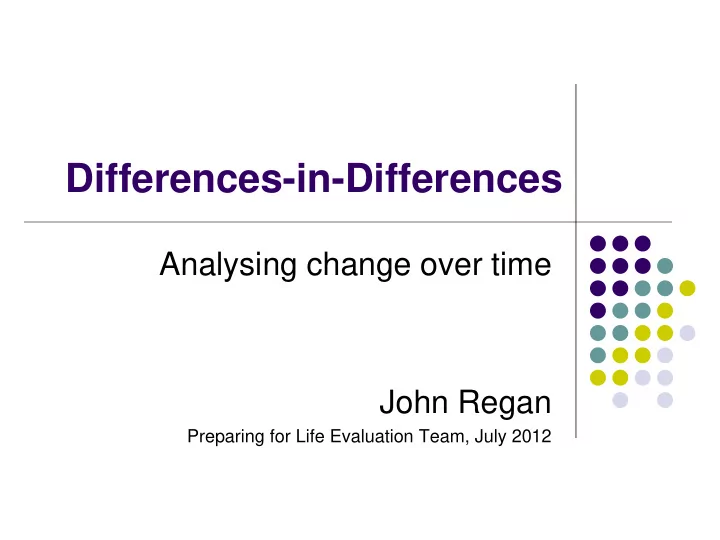

Differences-in-Differences Analysing change over time John Regan Preparing for Life Evaluation Team, July 2012
How do we analyse change over time? Evaluation team collect data at regular intervals using set questionnaires Questions are repeated at various points allowing a pre/post intervention analysis But what if some attributes (e.g. Maternal health) are improving over time for both Treatment and Control due to outside factors?
Identifying Assumption Whatever happens to the control group over time is what would have happened to the treatment group in the absence of the program.
Identifying Assumption Whatever happens to the control group over time is what would have happened to the treatment group in the absence of the program. Outcome Treatment Control Treatment Baseline 12 Month
Identifying Assumption Whatever happens to the control group over time is what would have happened to the treatment group in the absence of the program. Outcome Effect of program using only pre- & post- data from Treatment group (ignoring time trend). => Biased estimate Treatment Baseline 12 Month
Identifying Assumption Whatever happens to the control group over time is what would have happened to the treatment group in the absence of the program. Outcome Effect of program using only Treatment & Control comparison from post- intervention (ignoring pre-existing differences between T & C groups). Treatment Baseline 12 Month
Identifying Assumption Whatever happens to the control group over time is what would have happened to the treatment group in the absence of the program. Outcome Solution! Subtract the pre-existing difference from the post intervention difference Treatment Baseline 12 Month
Identifying Assumption Whatever happens to the control group over time is what would have happened to the treatment group in the absence of the program. Outcome Effect of program difference-in-difference (taking into account pre- existing differences between T & C and general time trend). Treatment Baseline 12 Month
Uses of Diff-in-Diff Simple two-period, two-group comparison Can also do much more complicated analysis, comparing two groups over many time periods Major component of evaluation from 12m+ Can be used in a Regression Framework
Preparing for Life Measure BL 6M 12M 18M 24M 36M 48M Parenting Risks (AAPI) X X X Knowledge of Parenting (KIDI) X X Parental Stress Index X X X Perceptions and Behaviours X X (Pacotis) Maternal Self Efficacy X X X X Psychological Well-being X X X X X Measure of HOME X X X Environment Indicators of Domestic Risk X X X X Ages & Stages Questionnaire X X X X X X Communication Development X X X
PFL Example WHO 5 Index- Maternal Psychological Well-Being Collected at Baseline, 6m, 12m, 36m and 48m Blue Green Baseline (mean) 57.94 54.26 6 Month (mean) 64.53 64.33 Difference 6.59 10.07 DID = 3.48 We can test this figure for significance using Regression
PFL Example 66.00 Who 5 64.00 62.00 60.00 58.00 56.00 54.00 Blue Green 52.00 Baseline 6 Month
PFL Example Variable Coefficient Std. Error t P Value 6 Month 6.59 3.22 2.05 0.04 Group -3.67 3.03 -1.21 0.23 6M x Group 3.48 4.44 0.78 0.43 Constant 57.94 2.29 25.4 0.00
References Angrist J., Pischke J.S. [2008], Mostly Harmless Econometrics, Princeton University Press, NJ Bertrand M., Duflo E. and Mullainathan S. [2004], How Much Should We Trust Differences-in-Differences Estimates?, in The Quarterly Journal of Economics , 2004, vol. 119, n. 1, pp. 249-275. Card D., Krueger A. [1994], Minimum Wages and Employment: A Case Study of the Fast-Food Industry in New Jersey and Pennsylvania, in «The American Economic Review», 1994, vol. 84, n. 4, pp. 772-793.
Recommend
More recommend